Business and Corporation Law
VerifiedAdded on 2023/03/30
|10
|3072
|410
AI Summary
This document discusses different business structures and the concept of negligence in business law. It explains the liability of partners in a partnership firm and provides expert guidance on business and corporation law.
Contribute Materials
Your contribution can guide someone’s learning journey. Share your
documents today.
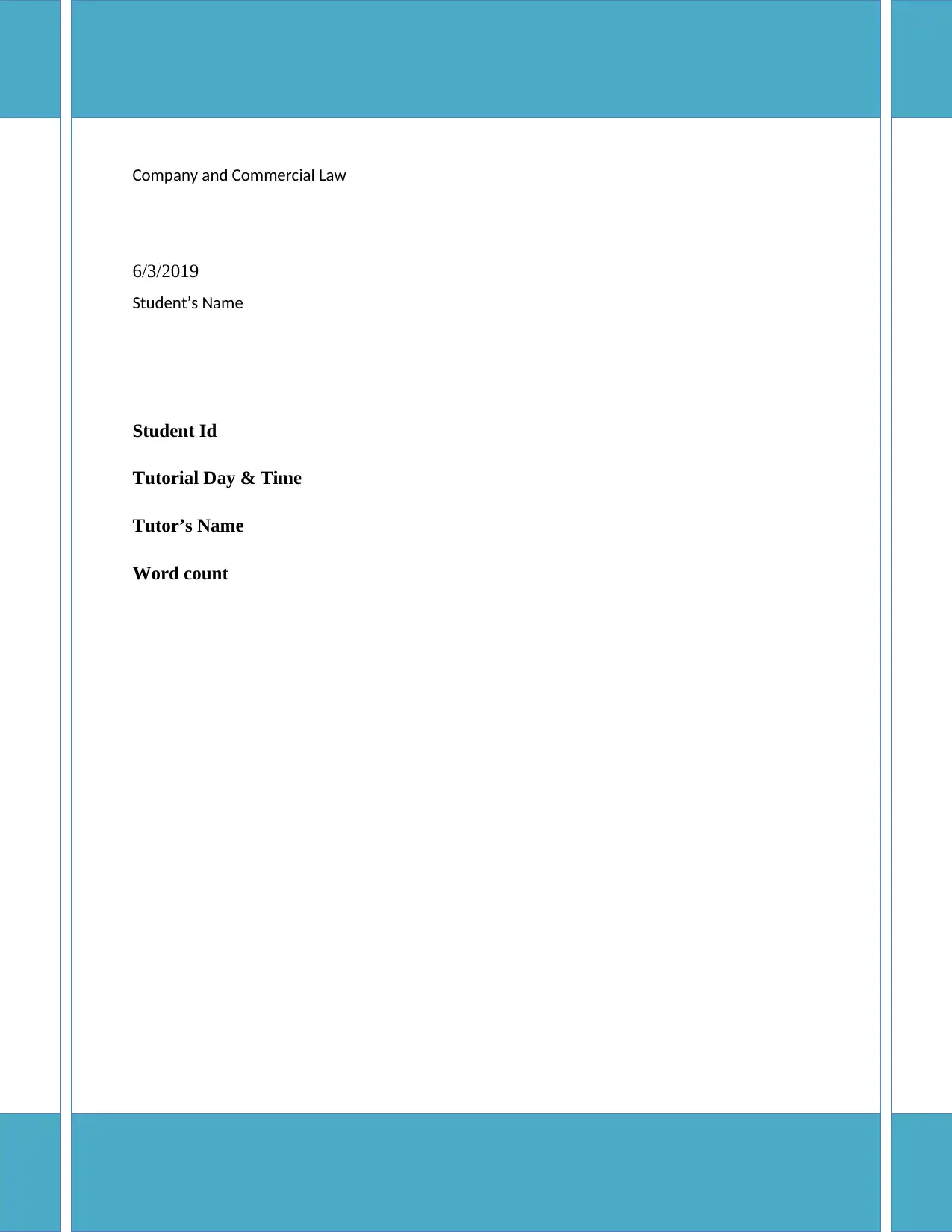
Running Head: BUSINESS AND CORPORATION LAW 0
Company and Commercial Law
6/3/2019
Student’s Name
Student Id
Tutorial Day & Time
Tutor’s Name
Word count
Company and Commercial Law
6/3/2019
Student’s Name
Student Id
Tutorial Day & Time
Tutor’s Name
Word count
Secure Best Marks with AI Grader
Need help grading? Try our AI Grader for instant feedback on your assignments.
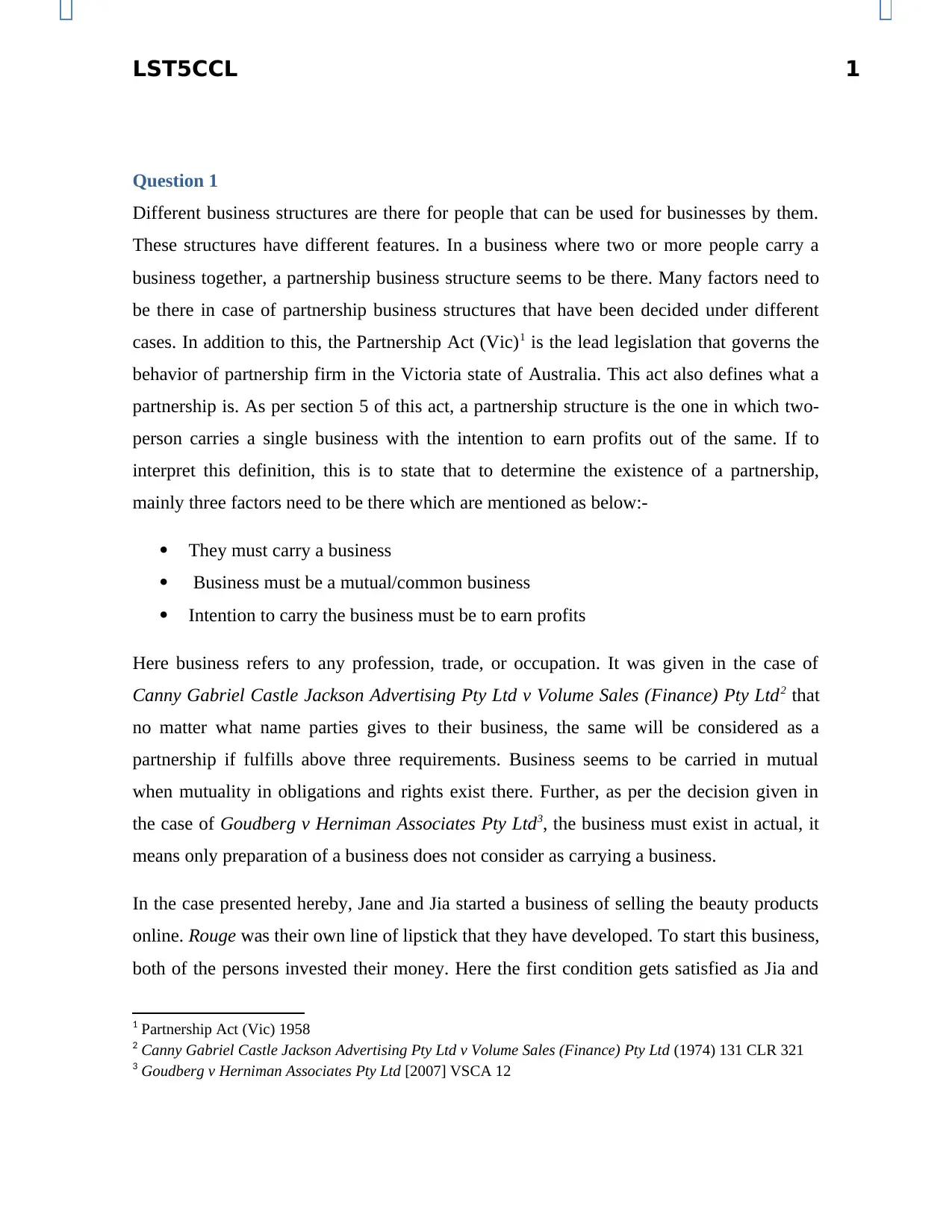
LST5CCL 1
Question 1
Different business structures are there for people that can be used for businesses by them.
These structures have different features. In a business where two or more people carry a
business together, a partnership business structure seems to be there. Many factors need to
be there in case of partnership business structures that have been decided under different
cases. In addition to this, the Partnership Act (Vic)1 is the lead legislation that governs the
behavior of partnership firm in the Victoria state of Australia. This act also defines what a
partnership is. As per section 5 of this act, a partnership structure is the one in which two-
person carries a single business with the intention to earn profits out of the same. If to
interpret this definition, this is to state that to determine the existence of a partnership,
mainly three factors need to be there which are mentioned as below:-
They must carry a business
Business must be a mutual/common business
Intention to carry the business must be to earn profits
Here business refers to any profession, trade, or occupation. It was given in the case of
Canny Gabriel Castle Jackson Advertising Pty Ltd v Volume Sales (Finance) Pty Ltd2 that
no matter what name parties gives to their business, the same will be considered as a
partnership if fulfills above three requirements. Business seems to be carried in mutual
when mutuality in obligations and rights exist there. Further, as per the decision given in
the case of Goudberg v Herniman Associates Pty Ltd3, the business must exist in actual, it
means only preparation of a business does not consider as carrying a business.
In the case presented hereby, Jane and Jia started a business of selling the beauty products
online. Rouge was their own line of lipstick that they have developed. To start this business,
both of the persons invested their money. Here the first condition gets satisfied as Jia and
1 Partnership Act (Vic) 1958
2 Canny Gabriel Castle Jackson Advertising Pty Ltd v Volume Sales (Finance) Pty Ltd (1974) 131 CLR 321
3 Goudberg v Herniman Associates Pty Ltd [2007] VSCA 12
Question 1
Different business structures are there for people that can be used for businesses by them.
These structures have different features. In a business where two or more people carry a
business together, a partnership business structure seems to be there. Many factors need to
be there in case of partnership business structures that have been decided under different
cases. In addition to this, the Partnership Act (Vic)1 is the lead legislation that governs the
behavior of partnership firm in the Victoria state of Australia. This act also defines what a
partnership is. As per section 5 of this act, a partnership structure is the one in which two-
person carries a single business with the intention to earn profits out of the same. If to
interpret this definition, this is to state that to determine the existence of a partnership,
mainly three factors need to be there which are mentioned as below:-
They must carry a business
Business must be a mutual/common business
Intention to carry the business must be to earn profits
Here business refers to any profession, trade, or occupation. It was given in the case of
Canny Gabriel Castle Jackson Advertising Pty Ltd v Volume Sales (Finance) Pty Ltd2 that
no matter what name parties gives to their business, the same will be considered as a
partnership if fulfills above three requirements. Business seems to be carried in mutual
when mutuality in obligations and rights exist there. Further, as per the decision given in
the case of Goudberg v Herniman Associates Pty Ltd3, the business must exist in actual, it
means only preparation of a business does not consider as carrying a business.
In the case presented hereby, Jane and Jia started a business of selling the beauty products
online. Rouge was their own line of lipstick that they have developed. To start this business,
both of the persons invested their money. Here the first condition gets satisfied as Jia and
1 Partnership Act (Vic) 1958
2 Canny Gabriel Castle Jackson Advertising Pty Ltd v Volume Sales (Finance) Pty Ltd (1974) 131 CLR 321
3 Goudberg v Herniman Associates Pty Ltd [2007] VSCA 12
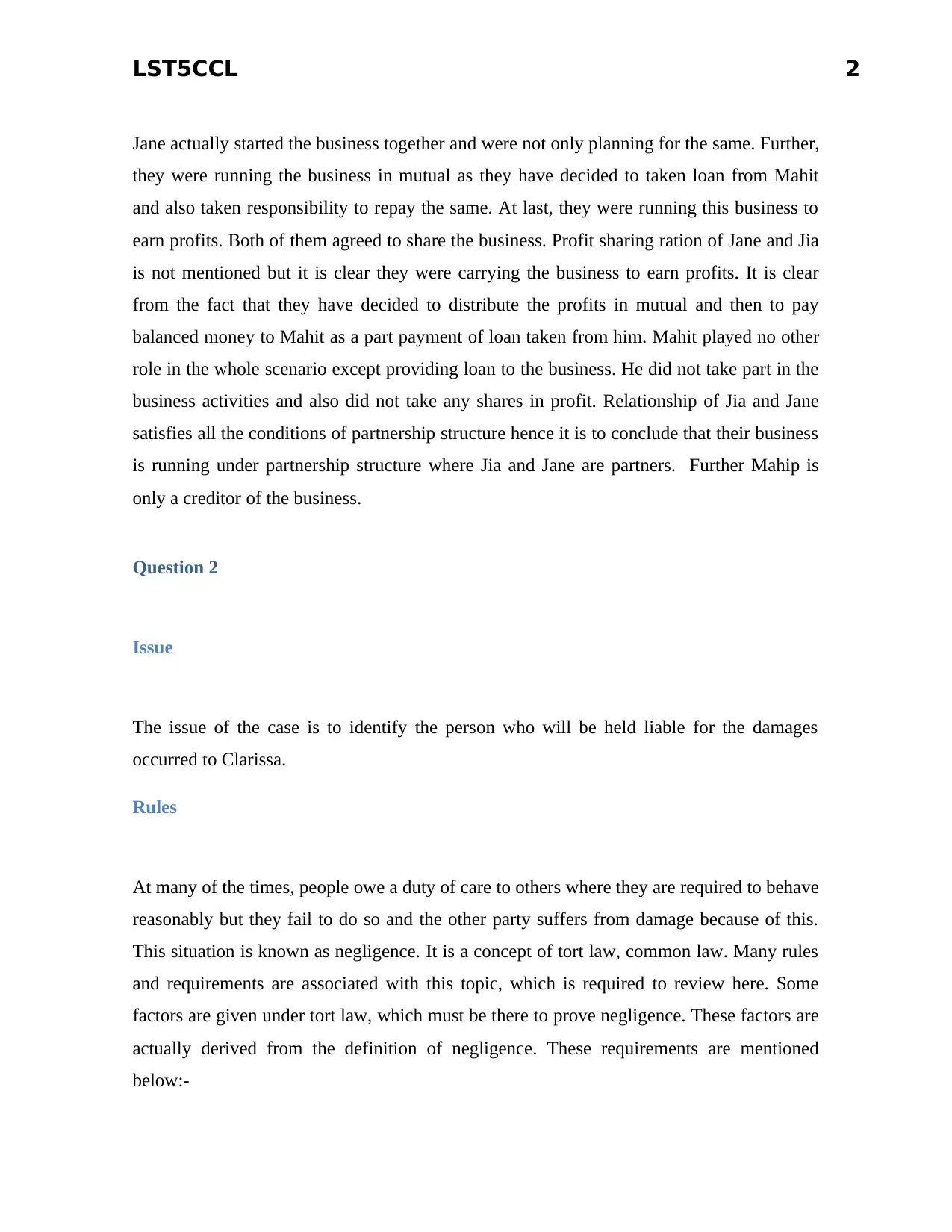
LST5CCL 2
Jane actually started the business together and were not only planning for the same. Further,
they were running the business in mutual as they have decided to taken loan from Mahit
and also taken responsibility to repay the same. At last, they were running this business to
earn profits. Both of them agreed to share the business. Profit sharing ration of Jane and Jia
is not mentioned but it is clear they were carrying the business to earn profits. It is clear
from the fact that they have decided to distribute the profits in mutual and then to pay
balanced money to Mahit as a part payment of loan taken from him. Mahit played no other
role in the whole scenario except providing loan to the business. He did not take part in the
business activities and also did not take any shares in profit. Relationship of Jia and Jane
satisfies all the conditions of partnership structure hence it is to conclude that their business
is running under partnership structure where Jia and Jane are partners. Further Mahip is
only a creditor of the business.
Question 2
Issue
The issue of the case is to identify the person who will be held liable for the damages
occurred to Clarissa.
Rules
At many of the times, people owe a duty of care to others where they are required to behave
reasonably but they fail to do so and the other party suffers from damage because of this.
This situation is known as negligence. It is a concept of tort law, common law. Many rules
and requirements are associated with this topic, which is required to review here. Some
factors are given under tort law, which must be there to prove negligence. These factors are
actually derived from the definition of negligence. These requirements are mentioned
below:-
Jane actually started the business together and were not only planning for the same. Further,
they were running the business in mutual as they have decided to taken loan from Mahit
and also taken responsibility to repay the same. At last, they were running this business to
earn profits. Both of them agreed to share the business. Profit sharing ration of Jane and Jia
is not mentioned but it is clear they were carrying the business to earn profits. It is clear
from the fact that they have decided to distribute the profits in mutual and then to pay
balanced money to Mahit as a part payment of loan taken from him. Mahit played no other
role in the whole scenario except providing loan to the business. He did not take part in the
business activities and also did not take any shares in profit. Relationship of Jia and Jane
satisfies all the conditions of partnership structure hence it is to conclude that their business
is running under partnership structure where Jia and Jane are partners. Further Mahip is
only a creditor of the business.
Question 2
Issue
The issue of the case is to identify the person who will be held liable for the damages
occurred to Clarissa.
Rules
At many of the times, people owe a duty of care to others where they are required to behave
reasonably but they fail to do so and the other party suffers from damage because of this.
This situation is known as negligence. It is a concept of tort law, common law. Many rules
and requirements are associated with this topic, which is required to review here. Some
factors are given under tort law, which must be there to prove negligence. These factors are
actually derived from the definition of negligence. These requirements are mentioned
below:-
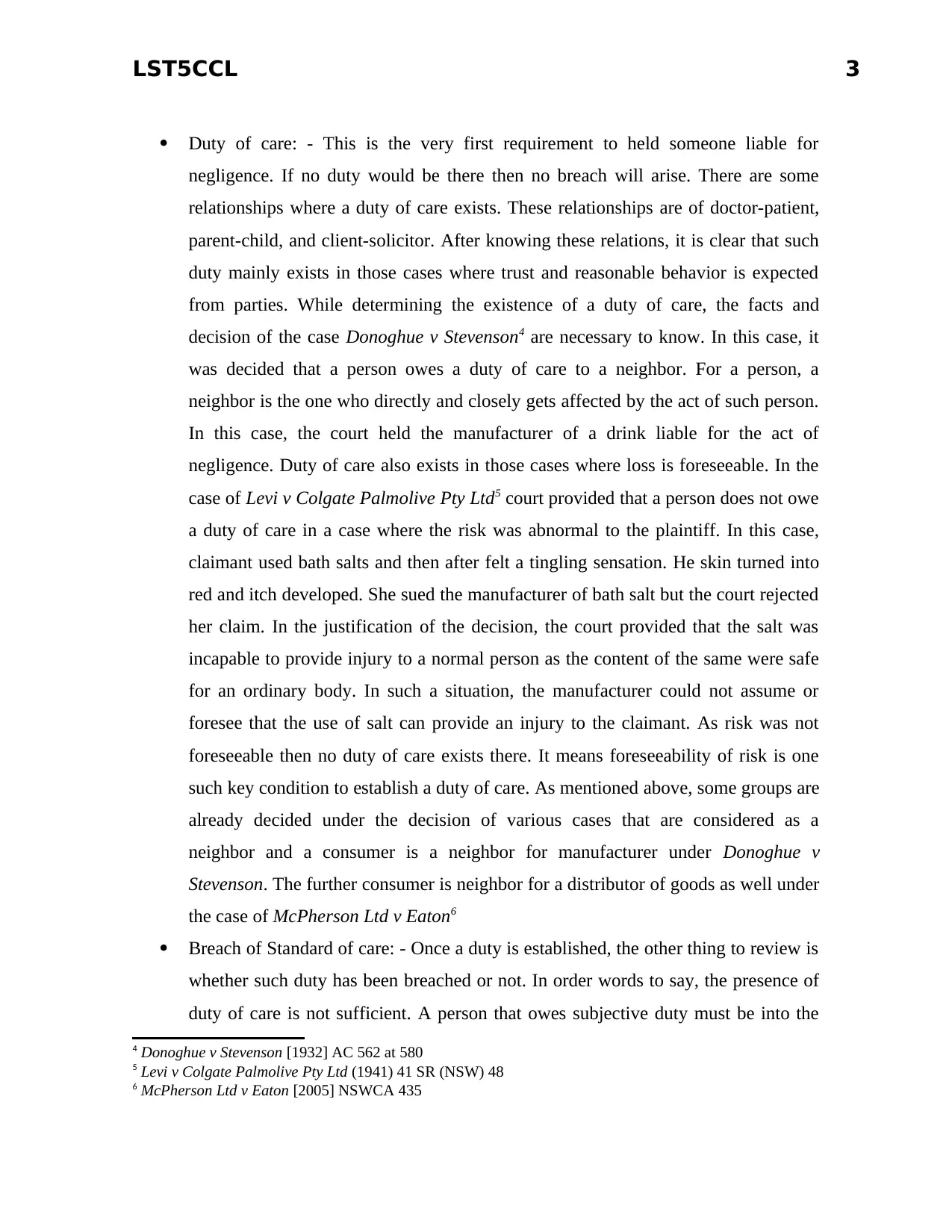
LST5CCL 3
Duty of care: - This is the very first requirement to held someone liable for
negligence. If no duty would be there then no breach will arise. There are some
relationships where a duty of care exists. These relationships are of doctor-patient,
parent-child, and client-solicitor. After knowing these relations, it is clear that such
duty mainly exists in those cases where trust and reasonable behavior is expected
from parties. While determining the existence of a duty of care, the facts and
decision of the case Donoghue v Stevenson4 are necessary to know. In this case, it
was decided that a person owes a duty of care to a neighbor. For a person, a
neighbor is the one who directly and closely gets affected by the act of such person.
In this case, the court held the manufacturer of a drink liable for the act of
negligence. Duty of care also exists in those cases where loss is foreseeable. In the
case of Levi v Colgate Palmolive Pty Ltd5 court provided that a person does not owe
a duty of care in a case where the risk was abnormal to the plaintiff. In this case,
claimant used bath salts and then after felt a tingling sensation. He skin turned into
red and itch developed. She sued the manufacturer of bath salt but the court rejected
her claim. In the justification of the decision, the court provided that the salt was
incapable to provide injury to a normal person as the content of the same were safe
for an ordinary body. In such a situation, the manufacturer could not assume or
foresee that the use of salt can provide an injury to the claimant. As risk was not
foreseeable then no duty of care exists there. It means foreseeability of risk is one
such key condition to establish a duty of care. As mentioned above, some groups are
already decided under the decision of various cases that are considered as a
neighbor and a consumer is a neighbor for manufacturer under Donoghue v
Stevenson. The further consumer is neighbor for a distributor of goods as well under
the case of McPherson Ltd v Eaton6
Breach of Standard of care: - Once a duty is established, the other thing to review is
whether such duty has been breached or not. In order words to say, the presence of
duty of care is not sufficient. A person that owes subjective duty must be into the
4 Donoghue v Stevenson [1932] AC 562 at 580
5 Levi v Colgate Palmolive Pty Ltd (1941) 41 SR (NSW) 48
6 McPherson Ltd v Eaton [2005] NSWCA 435
Duty of care: - This is the very first requirement to held someone liable for
negligence. If no duty would be there then no breach will arise. There are some
relationships where a duty of care exists. These relationships are of doctor-patient,
parent-child, and client-solicitor. After knowing these relations, it is clear that such
duty mainly exists in those cases where trust and reasonable behavior is expected
from parties. While determining the existence of a duty of care, the facts and
decision of the case Donoghue v Stevenson4 are necessary to know. In this case, it
was decided that a person owes a duty of care to a neighbor. For a person, a
neighbor is the one who directly and closely gets affected by the act of such person.
In this case, the court held the manufacturer of a drink liable for the act of
negligence. Duty of care also exists in those cases where loss is foreseeable. In the
case of Levi v Colgate Palmolive Pty Ltd5 court provided that a person does not owe
a duty of care in a case where the risk was abnormal to the plaintiff. In this case,
claimant used bath salts and then after felt a tingling sensation. He skin turned into
red and itch developed. She sued the manufacturer of bath salt but the court rejected
her claim. In the justification of the decision, the court provided that the salt was
incapable to provide injury to a normal person as the content of the same were safe
for an ordinary body. In such a situation, the manufacturer could not assume or
foresee that the use of salt can provide an injury to the claimant. As risk was not
foreseeable then no duty of care exists there. It means foreseeability of risk is one
such key condition to establish a duty of care. As mentioned above, some groups are
already decided under the decision of various cases that are considered as a
neighbor and a consumer is a neighbor for manufacturer under Donoghue v
Stevenson. The further consumer is neighbor for a distributor of goods as well under
the case of McPherson Ltd v Eaton6
Breach of Standard of care: - Once a duty is established, the other thing to review is
whether such duty has been breached or not. In order words to say, the presence of
duty of care is not sufficient. A person that owes subjective duty must be into the
4 Donoghue v Stevenson [1932] AC 562 at 580
5 Levi v Colgate Palmolive Pty Ltd (1941) 41 SR (NSW) 48
6 McPherson Ltd v Eaton [2005] NSWCA 435
Secure Best Marks with AI Grader
Need help grading? Try our AI Grader for instant feedback on your assignments.
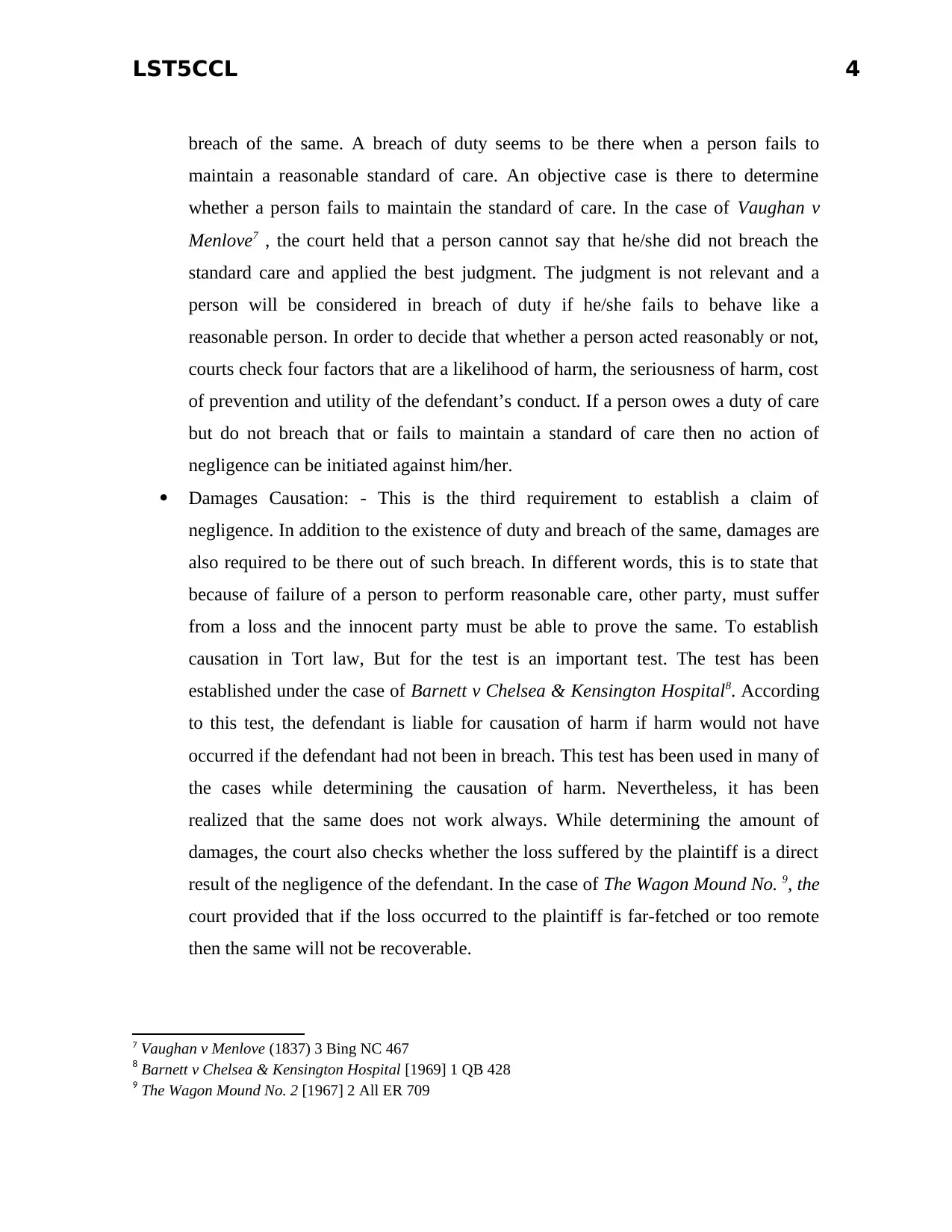
LST5CCL 4
breach of the same. A breach of duty seems to be there when a person fails to
maintain a reasonable standard of care. An objective case is there to determine
whether a person fails to maintain the standard of care. In the case of Vaughan v
Menlove7 , the court held that a person cannot say that he/she did not breach the
standard care and applied the best judgment. The judgment is not relevant and a
person will be considered in breach of duty if he/she fails to behave like a
reasonable person. In order to decide that whether a person acted reasonably or not,
courts check four factors that are a likelihood of harm, the seriousness of harm, cost
of prevention and utility of the defendant’s conduct. If a person owes a duty of care
but do not breach that or fails to maintain a standard of care then no action of
negligence can be initiated against him/her.
Damages Causation: - This is the third requirement to establish a claim of
negligence. In addition to the existence of duty and breach of the same, damages are
also required to be there out of such breach. In different words, this is to state that
because of failure of a person to perform reasonable care, other party, must suffer
from a loss and the innocent party must be able to prove the same. To establish
causation in Tort law, But for the test is an important test. The test has been
established under the case of Barnett v Chelsea & Kensington Hospital8. According
to this test, the defendant is liable for causation of harm if harm would not have
occurred if the defendant had not been in breach. This test has been used in many of
the cases while determining the causation of harm. Nevertheless, it has been
realized that the same does not work always. While determining the amount of
damages, the court also checks whether the loss suffered by the plaintiff is a direct
result of the negligence of the defendant. In the case of The Wagon Mound No. 9, the
court provided that if the loss occurred to the plaintiff is far-fetched or too remote
then the same will not be recoverable.
7 Vaughan v Menlove (1837) 3 Bing NC 467
8 Barnett v Chelsea & Kensington Hospital [1969] 1 QB 428
9 The Wagon Mound No. 2 [1967] 2 All ER 709
breach of the same. A breach of duty seems to be there when a person fails to
maintain a reasonable standard of care. An objective case is there to determine
whether a person fails to maintain the standard of care. In the case of Vaughan v
Menlove7 , the court held that a person cannot say that he/she did not breach the
standard care and applied the best judgment. The judgment is not relevant and a
person will be considered in breach of duty if he/she fails to behave like a
reasonable person. In order to decide that whether a person acted reasonably or not,
courts check four factors that are a likelihood of harm, the seriousness of harm, cost
of prevention and utility of the defendant’s conduct. If a person owes a duty of care
but do not breach that or fails to maintain a standard of care then no action of
negligence can be initiated against him/her.
Damages Causation: - This is the third requirement to establish a claim of
negligence. In addition to the existence of duty and breach of the same, damages are
also required to be there out of such breach. In different words, this is to state that
because of failure of a person to perform reasonable care, other party, must suffer
from a loss and the innocent party must be able to prove the same. To establish
causation in Tort law, But for the test is an important test. The test has been
established under the case of Barnett v Chelsea & Kensington Hospital8. According
to this test, the defendant is liable for causation of harm if harm would not have
occurred if the defendant had not been in breach. This test has been used in many of
the cases while determining the causation of harm. Nevertheless, it has been
realized that the same does not work always. While determining the amount of
damages, the court also checks whether the loss suffered by the plaintiff is a direct
result of the negligence of the defendant. In the case of The Wagon Mound No. 9, the
court provided that if the loss occurred to the plaintiff is far-fetched or too remote
then the same will not be recoverable.
7 Vaughan v Menlove (1837) 3 Bing NC 467
8 Barnett v Chelsea & Kensington Hospital [1969] 1 QB 428
9 The Wagon Mound No. 2 [1967] 2 All ER 709
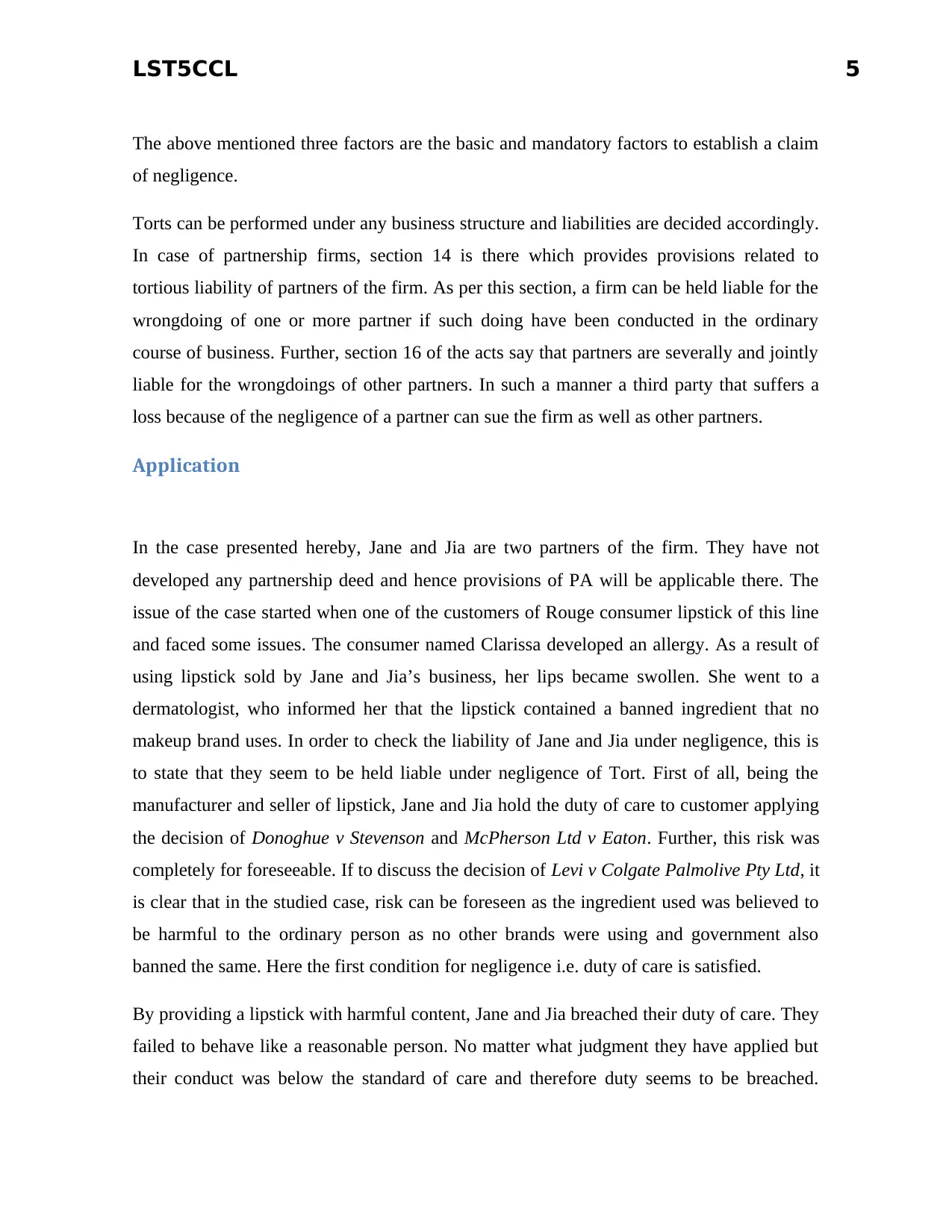
LST5CCL 5
The above mentioned three factors are the basic and mandatory factors to establish a claim
of negligence.
Torts can be performed under any business structure and liabilities are decided accordingly.
In case of partnership firms, section 14 is there which provides provisions related to
tortious liability of partners of the firm. As per this section, a firm can be held liable for the
wrongdoing of one or more partner if such doing have been conducted in the ordinary
course of business. Further, section 16 of the acts say that partners are severally and jointly
liable for the wrongdoings of other partners. In such a manner a third party that suffers a
loss because of the negligence of a partner can sue the firm as well as other partners.
Application
In the case presented hereby, Jane and Jia are two partners of the firm. They have not
developed any partnership deed and hence provisions of PA will be applicable there. The
issue of the case started when one of the customers of Rouge consumer lipstick of this line
and faced some issues. The consumer named Clarissa developed an allergy. As a result of
using lipstick sold by Jane and Jia’s business, her lips became swollen. She went to a
dermatologist, who informed her that the lipstick contained a banned ingredient that no
makeup brand uses. In order to check the liability of Jane and Jia under negligence, this is
to state that they seem to be held liable under negligence of Tort. First of all, being the
manufacturer and seller of lipstick, Jane and Jia hold the duty of care to customer applying
the decision of Donoghue v Stevenson and McPherson Ltd v Eaton. Further, this risk was
completely for foreseeable. If to discuss the decision of Levi v Colgate Palmolive Pty Ltd, it
is clear that in the studied case, risk can be foreseen as the ingredient used was believed to
be harmful to the ordinary person as no other brands were using and government also
banned the same. Here the first condition for negligence i.e. duty of care is satisfied.
By providing a lipstick with harmful content, Jane and Jia breached their duty of care. They
failed to behave like a reasonable person. No matter what judgment they have applied but
their conduct was below the standard of care and therefore duty seems to be breached.
The above mentioned three factors are the basic and mandatory factors to establish a claim
of negligence.
Torts can be performed under any business structure and liabilities are decided accordingly.
In case of partnership firms, section 14 is there which provides provisions related to
tortious liability of partners of the firm. As per this section, a firm can be held liable for the
wrongdoing of one or more partner if such doing have been conducted in the ordinary
course of business. Further, section 16 of the acts say that partners are severally and jointly
liable for the wrongdoings of other partners. In such a manner a third party that suffers a
loss because of the negligence of a partner can sue the firm as well as other partners.
Application
In the case presented hereby, Jane and Jia are two partners of the firm. They have not
developed any partnership deed and hence provisions of PA will be applicable there. The
issue of the case started when one of the customers of Rouge consumer lipstick of this line
and faced some issues. The consumer named Clarissa developed an allergy. As a result of
using lipstick sold by Jane and Jia’s business, her lips became swollen. She went to a
dermatologist, who informed her that the lipstick contained a banned ingredient that no
makeup brand uses. In order to check the liability of Jane and Jia under negligence, this is
to state that they seem to be held liable under negligence of Tort. First of all, being the
manufacturer and seller of lipstick, Jane and Jia hold the duty of care to customer applying
the decision of Donoghue v Stevenson and McPherson Ltd v Eaton. Further, this risk was
completely for foreseeable. If to discuss the decision of Levi v Colgate Palmolive Pty Ltd, it
is clear that in the studied case, risk can be foreseen as the ingredient used was believed to
be harmful to the ordinary person as no other brands were using and government also
banned the same. Here the first condition for negligence i.e. duty of care is satisfied.
By providing a lipstick with harmful content, Jane and Jia breached their duty of care. They
failed to behave like a reasonable person. No matter what judgment they have applied but
their conduct was below the standard of care and therefore duty seems to be breached.
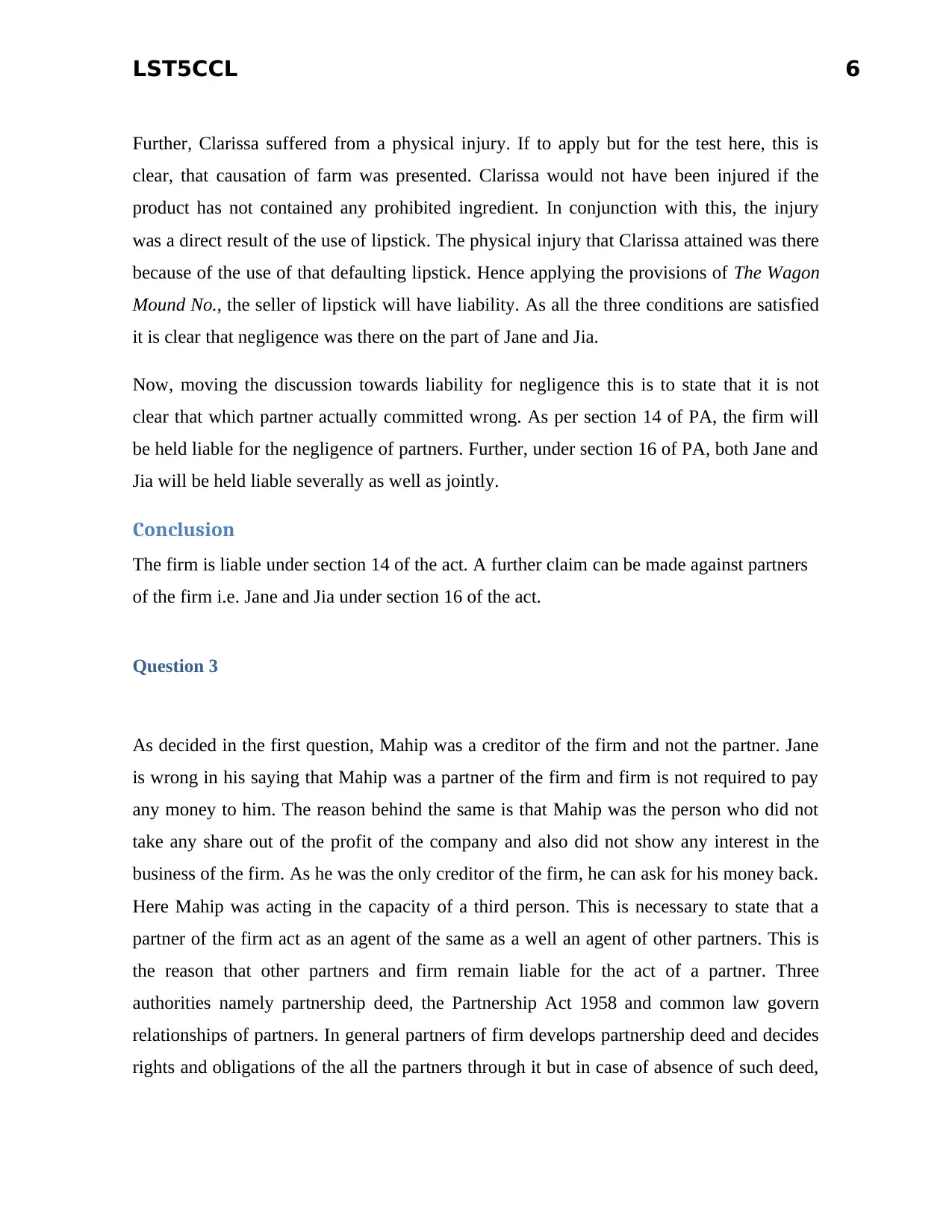
LST5CCL 6
Further, Clarissa suffered from a physical injury. If to apply but for the test here, this is
clear, that causation of farm was presented. Clarissa would not have been injured if the
product has not contained any prohibited ingredient. In conjunction with this, the injury
was a direct result of the use of lipstick. The physical injury that Clarissa attained was there
because of the use of that defaulting lipstick. Hence applying the provisions of The Wagon
Mound No., the seller of lipstick will have liability. As all the three conditions are satisfied
it is clear that negligence was there on the part of Jane and Jia.
Now, moving the discussion towards liability for negligence this is to state that it is not
clear that which partner actually committed wrong. As per section 14 of PA, the firm will
be held liable for the negligence of partners. Further, under section 16 of PA, both Jane and
Jia will be held liable severally as well as jointly.
Conclusion
The firm is liable under section 14 of the act. A further claim can be made against partners
of the firm i.e. Jane and Jia under section 16 of the act.
Question 3
As decided in the first question, Mahip was a creditor of the firm and not the partner. Jane
is wrong in his saying that Mahip was a partner of the firm and firm is not required to pay
any money to him. The reason behind the same is that Mahip was the person who did not
take any share out of the profit of the company and also did not show any interest in the
business of the firm. As he was the only creditor of the firm, he can ask for his money back.
Here Mahip was acting in the capacity of a third person. This is necessary to state that a
partner of the firm act as an agent of the same as a well an agent of other partners. This is
the reason that other partners and firm remain liable for the act of a partner. Three
authorities namely partnership deed, the Partnership Act 1958 and common law govern
relationships of partners. In general partners of firm develops partnership deed and decides
rights and obligations of the all the partners through it but in case of absence of such deed,
Further, Clarissa suffered from a physical injury. If to apply but for the test here, this is
clear, that causation of farm was presented. Clarissa would not have been injured if the
product has not contained any prohibited ingredient. In conjunction with this, the injury
was a direct result of the use of lipstick. The physical injury that Clarissa attained was there
because of the use of that defaulting lipstick. Hence applying the provisions of The Wagon
Mound No., the seller of lipstick will have liability. As all the three conditions are satisfied
it is clear that negligence was there on the part of Jane and Jia.
Now, moving the discussion towards liability for negligence this is to state that it is not
clear that which partner actually committed wrong. As per section 14 of PA, the firm will
be held liable for the negligence of partners. Further, under section 16 of PA, both Jane and
Jia will be held liable severally as well as jointly.
Conclusion
The firm is liable under section 14 of the act. A further claim can be made against partners
of the firm i.e. Jane and Jia under section 16 of the act.
Question 3
As decided in the first question, Mahip was a creditor of the firm and not the partner. Jane
is wrong in his saying that Mahip was a partner of the firm and firm is not required to pay
any money to him. The reason behind the same is that Mahip was the person who did not
take any share out of the profit of the company and also did not show any interest in the
business of the firm. As he was the only creditor of the firm, he can ask for his money back.
Here Mahip was acting in the capacity of a third person. This is necessary to state that a
partner of the firm act as an agent of the same as a well an agent of other partners. This is
the reason that other partners and firm remain liable for the act of a partner. Three
authorities namely partnership deed, the Partnership Act 1958 and common law govern
relationships of partners. In general partners of firm develops partnership deed and decides
rights and obligations of the all the partners through it but in case of absence of such deed,
Paraphrase This Document
Need a fresh take? Get an instant paraphrase of this document with our AI Paraphraser
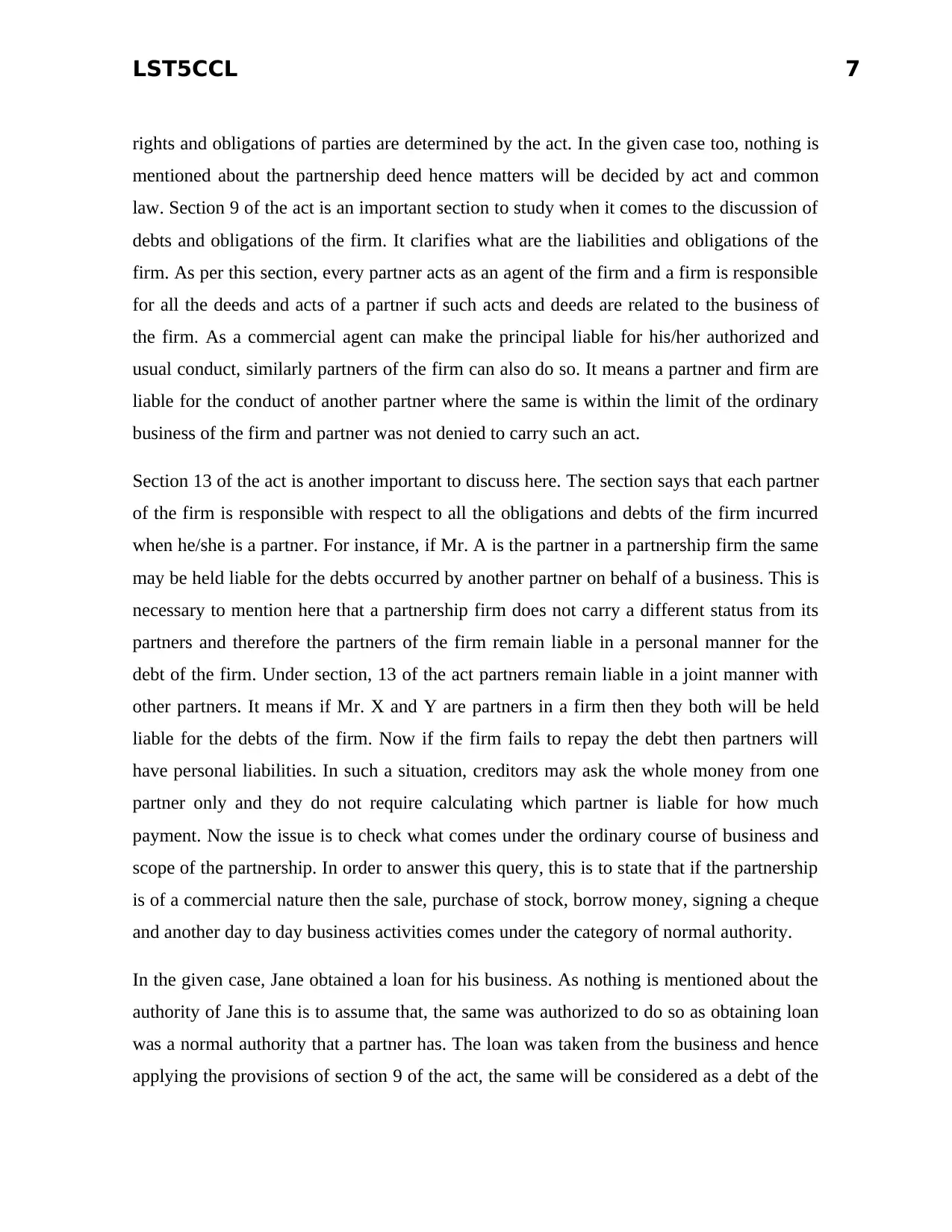
LST5CCL 7
rights and obligations of parties are determined by the act. In the given case too, nothing is
mentioned about the partnership deed hence matters will be decided by act and common
law. Section 9 of the act is an important section to study when it comes to the discussion of
debts and obligations of the firm. It clarifies what are the liabilities and obligations of the
firm. As per this section, every partner acts as an agent of the firm and a firm is responsible
for all the deeds and acts of a partner if such acts and deeds are related to the business of
the firm. As a commercial agent can make the principal liable for his/her authorized and
usual conduct, similarly partners of the firm can also do so. It means a partner and firm are
liable for the conduct of another partner where the same is within the limit of the ordinary
business of the firm and partner was not denied to carry such an act.
Section 13 of the act is another important to discuss here. The section says that each partner
of the firm is responsible with respect to all the obligations and debts of the firm incurred
when he/she is a partner. For instance, if Mr. A is the partner in a partnership firm the same
may be held liable for the debts occurred by another partner on behalf of a business. This is
necessary to mention here that a partnership firm does not carry a different status from its
partners and therefore the partners of the firm remain liable in a personal manner for the
debt of the firm. Under section, 13 of the act partners remain liable in a joint manner with
other partners. It means if Mr. X and Y are partners in a firm then they both will be held
liable for the debts of the firm. Now if the firm fails to repay the debt then partners will
have personal liabilities. In such a situation, creditors may ask the whole money from one
partner only and they do not require calculating which partner is liable for how much
payment. Now the issue is to check what comes under the ordinary course of business and
scope of the partnership. In order to answer this query, this is to state that if the partnership
is of a commercial nature then the sale, purchase of stock, borrow money, signing a cheque
and another day to day business activities comes under the category of normal authority.
In the given case, Jane obtained a loan for his business. As nothing is mentioned about the
authority of Jane this is to assume that, the same was authorized to do so as obtaining loan
was a normal authority that a partner has. The loan was taken from the business and hence
applying the provisions of section 9 of the act, the same will be considered as a debt of the
rights and obligations of parties are determined by the act. In the given case too, nothing is
mentioned about the partnership deed hence matters will be decided by act and common
law. Section 9 of the act is an important section to study when it comes to the discussion of
debts and obligations of the firm. It clarifies what are the liabilities and obligations of the
firm. As per this section, every partner acts as an agent of the firm and a firm is responsible
for all the deeds and acts of a partner if such acts and deeds are related to the business of
the firm. As a commercial agent can make the principal liable for his/her authorized and
usual conduct, similarly partners of the firm can also do so. It means a partner and firm are
liable for the conduct of another partner where the same is within the limit of the ordinary
business of the firm and partner was not denied to carry such an act.
Section 13 of the act is another important to discuss here. The section says that each partner
of the firm is responsible with respect to all the obligations and debts of the firm incurred
when he/she is a partner. For instance, if Mr. A is the partner in a partnership firm the same
may be held liable for the debts occurred by another partner on behalf of a business. This is
necessary to mention here that a partnership firm does not carry a different status from its
partners and therefore the partners of the firm remain liable in a personal manner for the
debt of the firm. Under section, 13 of the act partners remain liable in a joint manner with
other partners. It means if Mr. X and Y are partners in a firm then they both will be held
liable for the debts of the firm. Now if the firm fails to repay the debt then partners will
have personal liabilities. In such a situation, creditors may ask the whole money from one
partner only and they do not require calculating which partner is liable for how much
payment. Now the issue is to check what comes under the ordinary course of business and
scope of the partnership. In order to answer this query, this is to state that if the partnership
is of a commercial nature then the sale, purchase of stock, borrow money, signing a cheque
and another day to day business activities comes under the category of normal authority.
In the given case, Jane obtained a loan for his business. As nothing is mentioned about the
authority of Jane this is to assume that, the same was authorized to do so as obtaining loan
was a normal authority that a partner has. The loan was taken from the business and hence
applying the provisions of section 9 of the act, the same will be considered as a debt of the
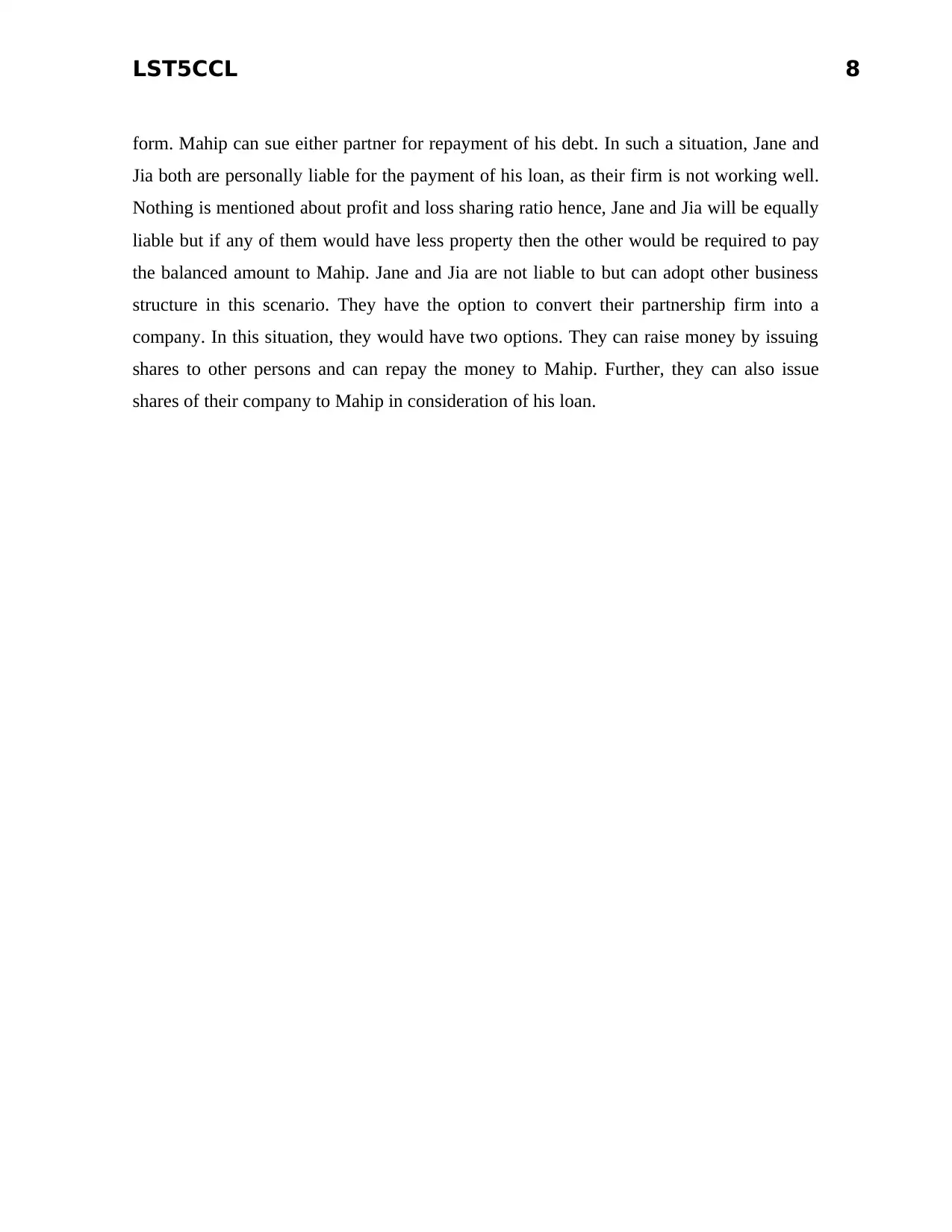
LST5CCL 8
form. Mahip can sue either partner for repayment of his debt. In such a situation, Jane and
Jia both are personally liable for the payment of his loan, as their firm is not working well.
Nothing is mentioned about profit and loss sharing ratio hence, Jane and Jia will be equally
liable but if any of them would have less property then the other would be required to pay
the balanced amount to Mahip. Jane and Jia are not liable to but can adopt other business
structure in this scenario. They have the option to convert their partnership firm into a
company. In this situation, they would have two options. They can raise money by issuing
shares to other persons and can repay the money to Mahip. Further, they can also issue
shares of their company to Mahip in consideration of his loan.
form. Mahip can sue either partner for repayment of his debt. In such a situation, Jane and
Jia both are personally liable for the payment of his loan, as their firm is not working well.
Nothing is mentioned about profit and loss sharing ratio hence, Jane and Jia will be equally
liable but if any of them would have less property then the other would be required to pay
the balanced amount to Mahip. Jane and Jia are not liable to but can adopt other business
structure in this scenario. They have the option to convert their partnership firm into a
company. In this situation, they would have two options. They can raise money by issuing
shares to other persons and can repay the money to Mahip. Further, they can also issue
shares of their company to Mahip in consideration of his loan.

LST5CCL 9
Bibliography
Legislations
Partnership Act (Vic) 1958
Cases
Barnett v Chelsea & Kensington Hospital [1969] 1 QB 428
Canny Gabriel Castle Jackson Advertising Pty Ltd v Volume Sales (Finance) Pty Ltd
(1974) 131 CLR 321
Donoghue v Stevenson [1932] AC 562 at 580
Goudberg v Herniman Associates Pty Ltd [2007] VSCA 12
Levi v Colgate Palmolive Pty Ltd (1941) 41 SR (NSW) 48
McPherson Ltd v Eaton [2005] NSWCA 435
The Wagon Mound No. 2 [1967] 2 All ER 709
Vaughan v Menlove (1837) 3 Bing NC 467
Bibliography
Legislations
Partnership Act (Vic) 1958
Cases
Barnett v Chelsea & Kensington Hospital [1969] 1 QB 428
Canny Gabriel Castle Jackson Advertising Pty Ltd v Volume Sales (Finance) Pty Ltd
(1974) 131 CLR 321
Donoghue v Stevenson [1932] AC 562 at 580
Goudberg v Herniman Associates Pty Ltd [2007] VSCA 12
Levi v Colgate Palmolive Pty Ltd (1941) 41 SR (NSW) 48
McPherson Ltd v Eaton [2005] NSWCA 435
The Wagon Mound No. 2 [1967] 2 All ER 709
Vaughan v Menlove (1837) 3 Bing NC 467
1 out of 10
Related Documents
Your All-in-One AI-Powered Toolkit for Academic Success.
+13062052269
info@desklib.com
Available 24*7 on WhatsApp / Email
![[object Object]](/_next/static/media/star-bottom.7253800d.svg)
Unlock your academic potential
© 2024 | Zucol Services PVT LTD | All rights reserved.





